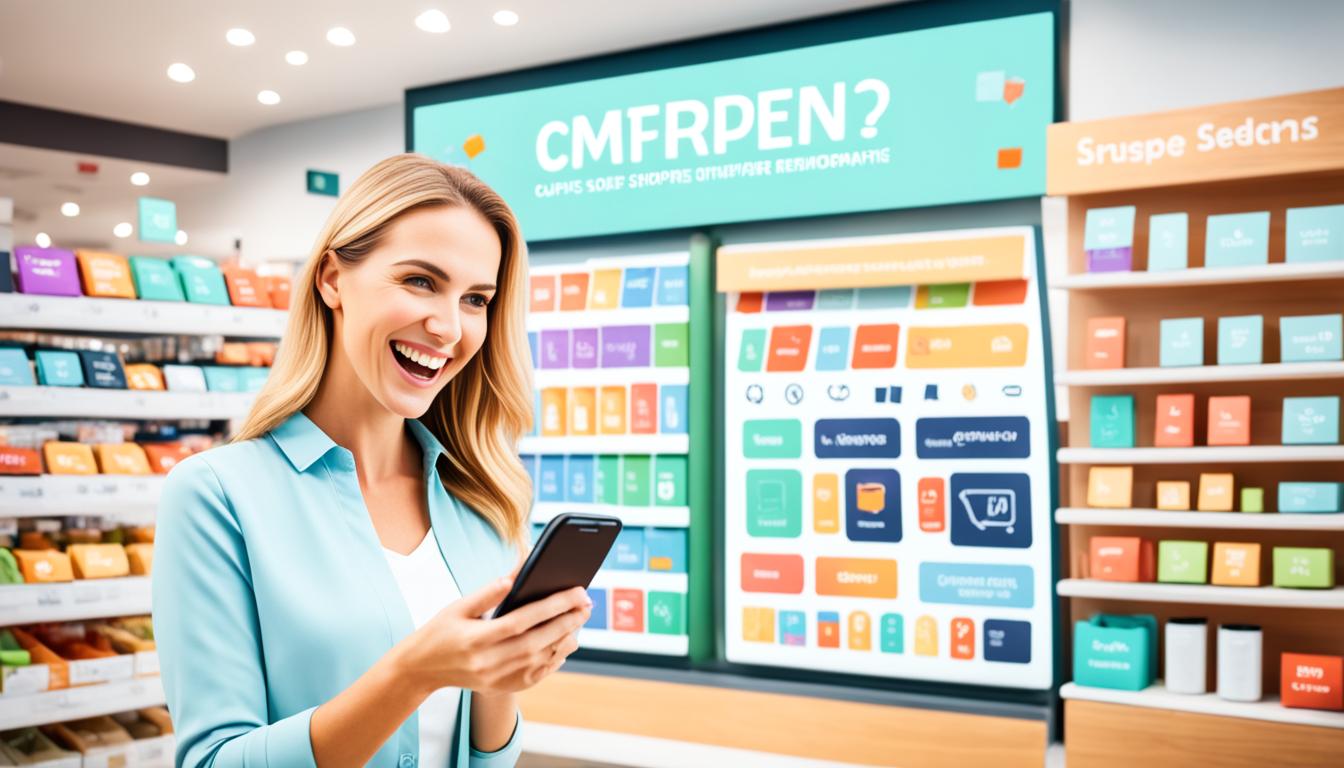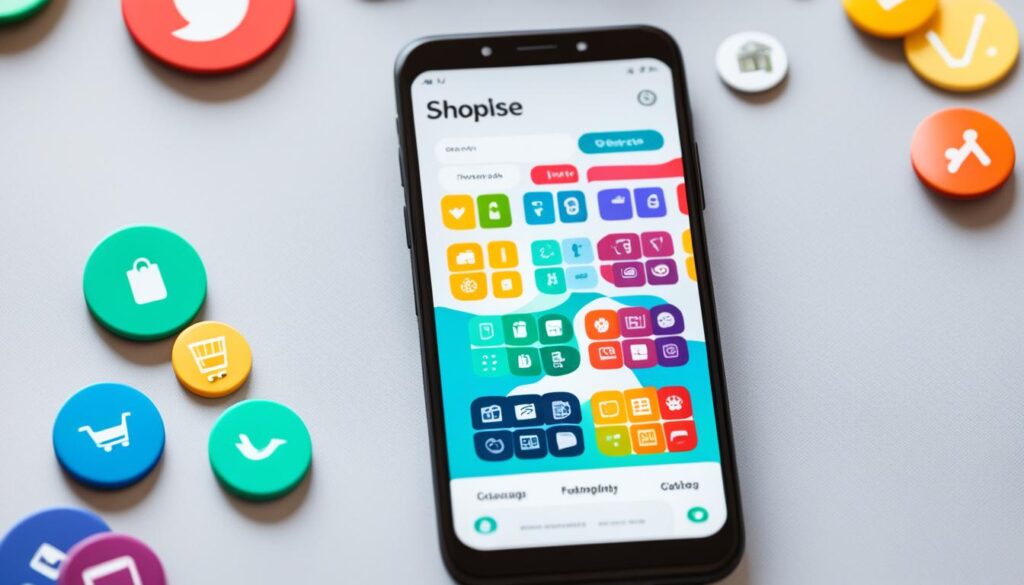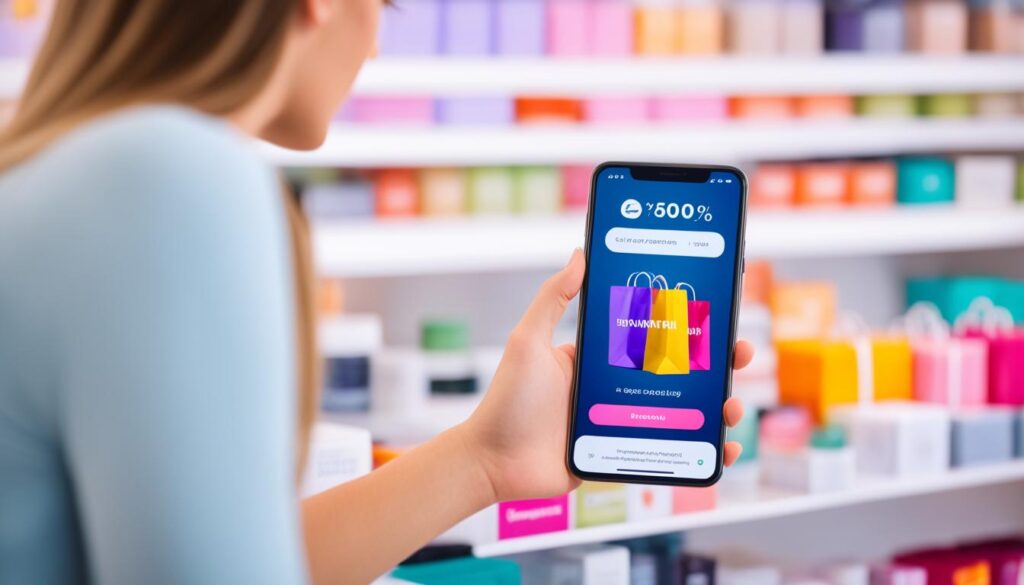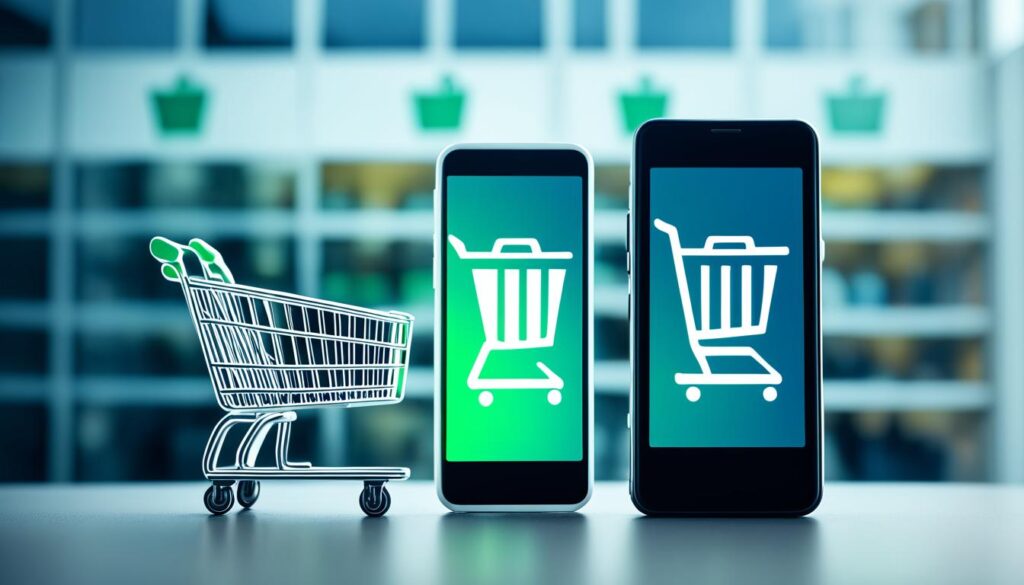The retail world has changed a lot in recent years. Now, customers want shopping experiences that are easy, personal, and blend online and offline. Retailers are turning to mobile apps to meet these needs. This helps them engage with customers better and increase sales.
Mobile apps let retailers reach out to customers anytime, anywhere. They make shopping easy and fun, fitting well with how people shop today. By using mobile devices, retailers can make shopping better, run smoother, and make more money through mobile shopping.
Table of Contents
Key Takeaways
- Retail mobile app development is key for a smooth, personal shopping experience.
- Mobile apps help retailers connect with customers easily and boost sales through mobile shopping.
- Good retail mobile apps should make shopping better, run smoother, and give useful insights into customer behavior.
- Keeping mobile apps safe and private is important to gain customer trust and protect their info.
- Keeping up with updates and marketing is vital for a retail mobile app’s long-term success.
The Importance of Mobile Apps in Retail
In today’s world, retail mobile apps are key for shopping. They help brands connect with customers and offer a smooth omnichannel retail experience. This is because how people shop is changing.
Changing Customer Behavior and Expectations
Customers now look for a shopping journey that’s easy and combines online and in-store. They want to check out products, compare prices, and buy on their phones. Mobile shopping trends have grown a lot, showing how important phones are in buying decisions.
The Role of Mobile Apps in Omnichannel Retail
Retail mobile apps link the physical and digital shopping worlds. They let customers look up products, check stock, and buy from their devices. By using mobile apps, businesses can give shoppers a smooth, personal experience. This helps with customer loyalty and sales.
“The rise of mobile shopping has changed retail, and businesses that use mobile apps will do well in the digital age.”
Key Features of Successful Retail Mobile Apps
Creating a hit retail mobile app means focusing on key features that boost the shopping experience and customer engagement. These include personalized product tips, easy in-app payments, loyalty rewards, and updates on what’s in stock.
One key feature is offering personalized product recommendations. By using customer data, apps can suggest products that fit what each shopper likes. This makes shopping on mobile more fun and satisfying.
Easy in-app payments and smooth checkout are also vital. Secure payment options mean customers can shop without hassle. This leads to more sales and happier customers.
- Personalized product recommendations
- In-app payments and checkout
- Loyalty programs and rewards
- Real-time inventory updates
- Push notifications and in-app messaging
Loyalty programs and rewards make shopping on mobile even better. They encourage customers to come back and buy more. Real-time updates and push notifications keep shoppers in the loop about what’s new and on sale.
“Successful retail mobile apps blend personalization, ease, and interaction for a shopping experience that really draws customers in.”
With these features, retail mobile apps offer a shopping experience that’s both unique and engaging. This leads to more customer engagement and helps businesses grow.
Enhancing the Shopping Experience
Retail mobile apps can change how we shop, making it more personal and easy. They offer personalized product recommendations by using what we like and buy. This makes finding new things we might like a breeze.
Apps also make shopping smoother with in-app payments and mobile checkout. These features let us pay safely and quickly right in the app. This cuts down on hassle and helps more people buy what they want, making them happier and more loyal customers.
| Feature | Benefit |
|---|---|
| Personalized Product Recommendations | Improved product discovery and increased customer engagement |
| In-App Payments and Mobile Checkout | Streamlined purchase process and reduced friction |
By using these new features, retail apps can make shopping on mobile both personal and efficient. They meet the changing needs and wants of today’s shoppers.
“Personalized product recommendations and in-app payments are game-changers in the retail mobile app landscape, transforming the way customers engage with and purchase from their favorite brands.”
Mobile App Integration with Retail Operations
For a retail mobile app to succeed, it must work well with a business’s systems. This is especially true for managing inventory and updating stock levels. These tasks can make shopping better for customers and help stores run smoother.
Inventory Management and Stock Updates
Mobile apps give customers real-time info on what’s in stock. This helps them decide what to buy without guessing. It saves them time by avoiding the disappointment of finding sold-out items.
Also, linking mobile apps with inventory systems helps stores keep track of their stock. Stores can order more when needed, keeping enough products for customers. This cuts down on stockouts and makes shopping better.
Linking mobile apps with retail operations is key to a great shopping experience. It keeps customers informed and helps stores manage their stock well. This approach boosts customer loyalty and engagement through mobile apps.
Leveraging Mobile App Analytics
In today’s digital world, mobile apps are full of data that helps us understand what customers like. By looking at how users act, what they buy, and how they engage, companies can make better choices. This leads to more customers sticking around and buying more.
Understanding Customer Behavior and Preferences
Mobile app analytics give retailers a deep look into what customers want. They track things like what users look at, what they search for, and how they interact with products. This helps businesses see what customers like and what they don’t.
With this info, retailers can make the app better for customers. They can make it easier to use, speed up the checkout, and add new features that customers want. This makes the shopping experience better for everyone.
Using mobile app analytics, retailers can make smart choices to improve the shopping experience. They can make the app easier to use, make buying things faster, and add new features that customers like. This keeps customers happy and coming back.
“Mobile app analytics are a game-changer for retailers, providing unparalleled visibility into customer behavior and allowing them to make data-driven decisions that drive engagement and sales.”
By using mobile app analytics well, retailers can stay ahead. They can see what customers will want next and keep their mobile strategies sharp. This helps them stay competitive in a fast-changing market.
Retail Mobile App Development for Enhanced Customer Engagement
Retail mobile apps are key for businesses wanting to boost customer interaction and offer a smooth shopping experience. By creating a well-thought-out, feature-packed retail mobile app, companies can forge deeper connections with their customers. This leads to ongoing growth.
A successful retail mobile app must offer a personalized and easy shopping journey. Features like personalized product recommendations, in-app payments, and loyalty programs meet the needs of today’s tech-savvy shoppers.
Features like augmented reality (AR) make shopping more engaging. Customers can see products in their own space before buying. Push notifications and in-app messages keep customers updated on deals, new products, and more.
| Key Features | Benefits |
|---|---|
| Personalized Product Recommendations | Increased customer engagement and sales |
| In-App Payments and Checkout | Streamlined shopping experience and reduced cart abandonment |
| Augmented Reality (AR) Integration | Enhanced product visualization and decision-making |
| Push Notifications and In-App Messaging | Timely and relevant customer communication |
Investing in retail mobile app development improves the mobile shopping experience. It also gives businesses deep insights into what customers like through mobile app analytics. This helps retailers make smart choices, refine their offerings, and boost customer engagement efforts.
“Retail mobile apps are no longer a luxury, but a necessity for businesses looking to thrive in the digital landscape.”
Mobile App Security and Data Privacy
In today’s fast-changing digital world, keeping customer info safe and private is crucial for mobile apps. When people share their personal details with businesses, these companies must keep their data secure. This builds trust and protects their important information.
Protecting Customer Information
Retail mobile apps deal with a lot of customer info, like personal details and payment info. To keep this data safe, companies need a strong plan for mobile app security and data privacy. This plan includes:
- Using top-notch encryption to keep data safe when it’s moving and when it’s stored
- Adding strong ways to check if a user is who they say they are, like biometric or multi-factor authentication
- Keeping an eye on and updating security steps to beat new threats
- Telling users how to keep their customer information protection safe
- Following rules and standards for data privacy and security
| Security Measure | Description |
|---|---|
| Encryption | Use advanced encryption to keep data safe, both when it’s being sent and when it’s stored, protecting important customer info. |
| Authentication | Put in strong ways to check if a user is really who they say they are, like biometric or multi-factor authentication, to stop unauthorized access. |
| Regulatory Compliance | Make sure the mobile app follows rules and standards for data privacy and security, like GDPR or HIPAA, to keep customers trusting you. |
By focusing on mobile app security and data privacy, retail businesses can create a strong trust with their customers. This leads to loyalty and success in the competitive digital market.
Cross-Platform Development Approaches
Retailers now aim to reach customers on many devices and platforms. Using frameworks like React Native or Flutter helps make apps work well on both iOS and Android. This ensures a smooth experience for users and reaches more people.
One big plus of cross-platform app making is saving time and money. Instead of making separate apps for each system, one codebase works on many platforms. This cuts down on development costs and time.
Also, cross-platform mobile app development means faster updates for everyone. New features and fixes reach all customers, no matter their device. This is key in retail, where things change fast and customers expect quick updates.
Choosing the right approach depends on the retailer’s needs and audience. Sometimes, native iOS and Android development is best for using special hardware or platform features.
The choice between cross-platform or native development for a retail mobile app comes down to knowing the audience, app needs, and business goals. By considering these factors, retailers can make sure their multi-platform retail apps give users a great experience.
“Successful retail mobile apps must provide a consistent and intuitive experience across all customer touchpoints, regardless of their device or platform preferences.”
User Experience (UX) Design Considerations
Making a great user experience (UX) is key for a retail mobile app’s success. This means adding intuitive navigation, smooth task flows, and design that’s easy to use. These make the app fun and simple for customers.
Intuitive Navigation and Usability
A successful retail mobile app needs great mobile app usability. Users want to move through the app easily and find what they need fast. Good mobile app UX design makes the app engaging and keeps users coming back.
- Streamlined information architecture: Organize content and features logically to minimize cognitive load and enhance user comprehension.
- Intuitive navigation: Implement clear navigation menus, simple gestures, and contextual cues to guide users through the app effortlessly.
- Responsive design: Ensure the app adapts seamlessly to different screen sizes and device orientations, providing a consistent experience across platforms.
- Personalized experience: Leverage user data to tailor the interface and content to individual preferences, creating a more relevant and engaging experience.
| Feature | Benefit |
|---|---|
| Intuitive Navigation | Enhances user experience and reduces cognitive load, leading to higher customer satisfaction and engagement. |
| Responsive Design | Delivers a consistent and optimized experience across various devices, catering to the diverse needs of customers. |
| Personalized Experience | Increases customer loyalty by providing a tailored and relevant experience, addressing individual preferences and needs. |
“Thoughtful UX design is the key to creating a retail mobile app that customers will love to use and keep coming back to.”
Integrating Augmented Reality (AR) and Virtual Reality (VR)
The retail world has changed a lot lately, thanks to new tech like AR and VR in mobile shopping. These new tools are changing how customers interact with products and brands. They make shopping more fun and can really boost sales and keep customers coming back.
AR and VR in retail apps let customers try on products or see them in their own space without leaving home. This makes customers happier and less likely to return items. It helps increase sales and makes shopping better overall.
For instance, with AR apps, customers can see how furniture would fit in their home or try makeup products virtually before buying. VR takes it further, letting customers explore products in a full digital store from home.
Immersive shopping experiences from mobile commerce technology are not just fun but also really work to get customers involved and boost sales. Stores that use AR and VR in their apps are leading the way. They give customers a shopping experience they won’t forget.
Push Notifications and In-App Messaging
In the retail mobile app world, push notifications and in-app messaging are key for engaging customers and increasing sales. These tools let retailers send updates to users at the right time. They keep users in the loop about new deals, product launches, or recommendations based on what they like.
Using mobile app push notifications smartly can grab customers’ attention even when they’re not using the app. Well-thought-out notifications can tell users about special deals, flash sales, or products they might like. In-app messaging lets retailers talk to customers right in the app, making the experience smooth and interactive.
To make personalized customer communication work, it’s important to know what users like and do. Retailers can use app analytics to see what products users look at, which features they use, and how they move through the app. With this info, retailers can send push notifications and in-app messages that really speak to their customers, boosting engagement and sales.
“Mobile app push notifications and in-app messaging are powerful tools that allow retailers to connect with customers in a personalized and timely manner, ultimately enhancing the overall shopping experience.”
By mixing informative and promotional content just right, retailers can use push notifications and in-app messaging to create a sense of urgency. This helps build brand loyalty and gets customers to come back to the app more often. This smart way of talking to customers can really set a retailer apart in the competitive market.
Mobile App Monetization Strategies
In the competitive mobile app world, apps often make little money. Mobile app monetization strategies are key for retail businesses to grow and make money. Retail mobile apps can use different ways to make money, each with its own pros and cons.
In-app purchases let users buy digital stuff, virtual goods, or extra features in the app. This method can make users more engaged and bring in steady money. Subscription models give apps regular money and work well for apps with lots of content or special services.
| Monetization Strategy | Advantages | Disadvantages |
|---|---|---|
| In-App Purchases | Increased user engagement, reliable revenue | Potential user resistance to paid features |
| Subscription Models | Recurring revenue, content exclusivity | User churn, higher acquisition costs |
| Advertising (Interstitial, Native) | Monetize free users, potential for scale | Intrusive user experience, limited control |
Businesses need to pick the best mobile app monetization method for their audience, app, and goals. By choosing the right strategies, retail mobile apps can make good money and stay strong in the changing app market.
“Effective mobile app monetization is essential for retail businesses to drive sustainable growth and profitability in the competitive app market.”
Continuous App Maintenance and Updates
Keeping a retail mobile app up to date is key. It makes sure the app stays relevant, secure, and meets customer demands and industry trends. A strong app maintenance and update strategy is needed. This includes fixing bugs, adding new features, and keeping up with tech changes or what customers want.
Keeping Up with Industry Trends and Customer Demands
Staying ahead in mobile app development is crucial. Retailers need to watch industry trends and listen to their customers. This helps them know what to improve. By meeting customer demands, apps can become more useful and improve the shopping experience.
Regular app updates fix technical problems and add new stuff. This keeps the app fresh and meets user needs. It shows a commitment to a great mobile experience. This can make customers more loyal and happy.
| Key Factors for Continuous App Maintenance and Updates | Benefits |
|---|---|
|
|
By being proactive with mobile app maintenance and updates, retailers can lead the competition. They can offer a smooth, personalized, and engaging mobile experience. This keeps customers coming back.
Mobile App Marketing and Promotion
Effective mobile app marketing and promotion are key to getting customers to know, buy, and use your app. Companies need to use different strategies to reach and turn potential users into real ones for their apps.
App store optimization (ASO) is a big part of this. It means making the app’s title, description, and keywords better so it shows up more in app stores. This way, the app can draw in more people who are actually interested in it, leading to more downloads.
Using advertising campaigns on social media, search engines, and in-app can also work well. By targeting ads to specific people and using data to guide them, companies can send messages that really speak to their audience.
Social media is great for user engagement and app promotion. Companies can post interesting stuff, run contests, and work with influencers to get their app out there and get more downloads.
In-store promotional activities like signs, demos, and special deals can really help get people to download your app. By linking the app to the in-store experience, companies can make sure customers have a smooth journey across all channels.
At the end of the day, a strong mobile app marketing plan that uses many channels and strategies is key. This way, a retail mobile app can reach more people and have a bigger impact.
“Effective mobile app marketing is the key to unlocking the full potential of a retail mobile app. By reaching the right customers through the right channels, businesses can drive meaningful engagement and long-term loyalty.”
Conclusion
Creating a strong retail mobile app can change the game for businesses. It helps improve customer interaction, make things run smoother, and boost sales. Features like personalized product tips, easy in-app payments, and managing stock can make shopping smooth and fun.
It’s key to link the app with your business well and use data to get to know your customers. Keeping customer info safe and private is also crucial. A focus on the customer, using new tech like augmented and virtual reality, and smart marketing can make your brand stand out.
As shopping habits change, using mobile tech with a great app can give businesses an edge. It helps connect better with customers, makes things more efficient, and taps into the growing mobile shopping world.














